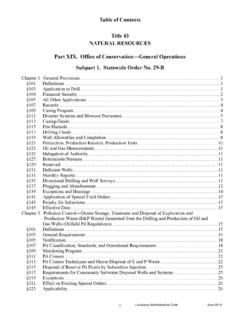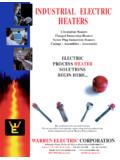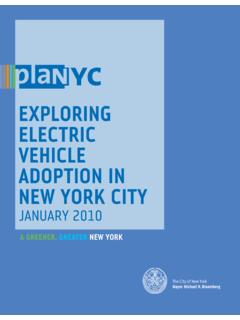Transcription of Chapter 7 Heating, Ventilation, and Air Conditioning
1 Chapter 7 heating , ventilation , and Air Conditioning 123 Chapter 7 heating , ventilation , and Air Conditioning One of the most important decisions regarding a new home is the type of heating and cooling system to install. Equally critical is the heating and cooling contractor selected, as the operating efficiency of a system depends as much on proper installation as it does on the performance rating. Keys to obtaining the design efficiency of a system in the field include: Sizing and selecting the system for the heating , cooling, and dehumidification load of the home being built Correct design of the ductwork or piping Proper installation and charging of the HVAC unit Insulating and sealing all ductwork or piping Types of HVAC Systems There are two primary types of central heating systems - forced-air systems and radiant heating systems.
2 Most new homes have forced-air heating and cooling systems - either using a central furnace and air conditioner or a heat pump. Figure 7-1 shows that in forced-air systems a series of ducts distribute the conditioned heated or cooled air throughout the home. The conditioned air is forced through the ducts by a blower, located in a unit called an air handler. Most homes in Louisiana have three choices for central, forced-air systems: electric resistance heat or fuel-fired furnaces with electric air Conditioning units or electric heat pumps, which can be either air-source or ground-source (geothermal). The best system for each home depends on many factors -- cost, comfort, efficiency, annual energy use, availability, and local prices for fuels and electricity.
3 Figure 7-1 Components of Forced-Air Systems When considering a HVAC system for a residence, remember that energy efficient homes have less demand for heating and cooling, so substantial cost savings may be obtained by installing smaller units that are properly sized to meet the load. Because energy bills in more efficient homes are Return Plenum Filter should be in a convenient location Refrigerant Lines heating Source Blower Supply Plenum Branch Duct Trunk Duct Evaporation Coil Condensate Line 124 lower, higher efficiency systems will not provide as much annual savings on energy bills and may not be as cost effective as in less efficient houses.
4 Sizing It is important to size heating and air Conditioning systems properly. Not only does oversized equipment cost more, but it can waste energy and may decrease comfort. Do not rely on rule-of-thumb methods to size HVAC equipment. Many contractors select air Conditioning systems based on a rule such as 500 square feet of cooled area per ton of air Conditioning (a ton provides 12,000 Btu per hour of cooling). Instead, use a sizing procedure such as: Calculations in Manual J published by the Air Conditioning Contractors Association Similar procedures developed by the American Society of heating , Refrigeration, and Air Conditioning Engineers (ASHRAE) Software procedures developed by electrical or gas utilities, the Department of Energy, HVAC equipment manufacturers, or private software companies The heating and cooling load calculations rely on the size and type of construction for each component of the building envelope, as well as the heat given off by the lights, people, and equipment inside the house.
5 If a zoned heating and cooling system is used, the loads in each zone should be calculated separately. Simplified rules of thumb typically provide oversized heating and cooling systems for more efficient homes. Oversized units cost more to install, increase energy bills, suffer greater wear and tear, and often may not provide adequate dehumidification. It takes about 15 minutes for most air conditioners to reach peak efficiency. During extreme outside temperatures (under 32 F in winter and over 88 F in summer) the system should run about 80% of the time. Oversized systems cool the home quickly and often do not operate long enough to reach peak efficiency.
6 Proper sizing includes designing the cooling system to provide adequate dehumidification. In Louisiana's humid climate it is critical to calculate the latent load - the amount of dehumidification needed for the home. If the latent load is ignored, the home may become uncomfortable due to excess humidity. The Sensible heating Fraction (SHF) designates the portion of the cooling load for reducing indoor temperatures (sensible cooling). For example, in a HVAC unit with a SHF, 75% of the energy expended by the unit goes to cool the indoor air. The remaining 25% goes for latent heat removal - taking moisture out of the air in the home.
7 The Manual J system sizing procedure includes calculations to estimate latent load. Many homes in Louisiana have design SHFs of approximately , that is, 70% of the cooling will be sensible and 30% latent. Systems that deliver less than 30% latent cooling may fail to provide adequate dehumidification in summer. Temperature Controls The most basic type of control system is a heating and cooling thermostat. Programmable thermostats, also called setback thermostats, can be big energy savers for homes by automatically adjusting the temperature setting when people are sleeping or are not at home. Be certain that the programmable thermostat selected is designed for the particular heating and cooling equipment it will be controlling.
8 This is especially important for heat pumps, as an improper programmable thermostat can actually increase energy bills. Chapter 7 heating , ventilation , and Air Conditioning 125 A thermostat should be located centrally within the house or zone on an interior wall. It should not receive direct sunlight or be near a heat-producing appliance. A good location is often 4 to 5 feet above the floor in an interior hallway near a return air grille. The interior wall, on which the thermostat is installed, like all walls, should be well sealed at the top and bottom to prevent circulation of cool air in winter or hot air in summer. Some homeowners have experienced excessive energy bills and discomfort for years because air from the attic leaked into the wall cavity behind the thermostat and caused the cooling or heating system to run much longer than needed.
9 Multiple HVAC Zones Larger homes often use two or more separate heating and air Conditioning units for different floors or areas. Multiple systems can maintain greater comfort throughout the house while saving energy by allowing different zones of the house to be at different temperatures. The greatest savings come when a unit serving an unoccupied zone can be turned off. Rather than install two separate systems, HVAC contractors can provide automatic zoning systems that operate with one system. The ductwork in these systems typically has a series of thermostatically controlled dampers that regulate the flow of air to each zone. Although somewhat new in residential construction, thermostats, dampers, and controls for zoning large central systems have been used for years in commercial buildings.
10 If your heating and air Conditioning subcontractor feels that installing two or three separate HVAC units is needed, have them also estimate the cost of a single system with damper control over the ductwork. A single, larger system running longer is usually more efficient than separate systems. Such a system must be carefully designed to ensure that the blower is not damaged if dampers are closed to several supply ducts. In this situation, the blower still tries to deliver the same air flow as before, but now through only a few ducts. The reduced air flow creates back pressure against the blades of the blower and may cause damage to the motor.













